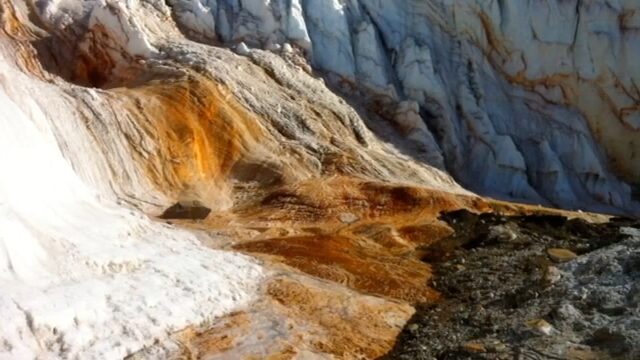What’s the Mystery Behind Blood Falls in Antarctica? Nature’s Red Riddle
Ever wondered why a glacier in Antarctica bleeds red? Blood Falls in Antarctica, a striking crimson streak oozing from Taylor Glacier, has puzzled explorers since 1911. It’s not gore but a natural marvel hiding ancient secrets and thriving microbes. Let’s unravel its origins, science, and cosmic clues in this 1500-word journey through one of Earth’s wildest wonders.
Where Is Blood Falls Located? A Remote Antarctic Marvel
Deep in the McMurdo Dry Valleys, Blood Falls in Antarctica stain the Taylor Glacier’s icy face. It flows into West Lake Bonney, painting the ice a vivid red. This Mars-like desert, with no rain or snow, sits in Victoria Land. The falls emerge from a crack 400 meters beneath the glacier.
Named after geologist Thomas Griffith Taylor, the valley’s harsh terrain feels alien. It’s a trek only scientists with permits can make. The falls drop 18-24 meters, a rare summer drip in a frozen world. It’s like Antarctica’s showing off its weird side.
How Was Blood Falls Discovered? A Century-Old Puzzle
In 1911, Griffith Taylor’s team spotted the red streak during the Terra Nova Expedition. They jokingly called it Blood Falls in Antarctica. Early guesses pointed to red algae, but tests showed no such life. The color remained a head-scratcher for decades.
In the 2000s, scientist Jill Mikucki took samples, tasting the salty brine. Her work cracked the mystery wide open. By 2017, radar had mapped the hidden source, turning folklore into fact. It’s now a beacon for polar research.

Why Does It Look Like Blood? The Iron Secret
What makes Blood Falls in Antarctica so red? It’s iron-rich brine, clear underground but rusting when it hits air. The brine, six times saltier than seawater, stays liquid at -17°C. Iron oxidizes into a rusty hue, like a browning apple.
Sulfate and ferric iron (Fe³⁺) drive the color, seeping from glacier cracks. It’s chemistry, not carnage, at work. This hypersaline water pulses sporadically, staining the ice in bursts. Nature’s pulling a dramatic stunt here.
What’s the Source? A Hidden Subglacial Lake
Beneath Taylor Glacier lies a sealed subglacial lake, trapped for 1.5-2 million years. It’s the heart of Blood Falls in Antarctica. Ice locked this ancient saltwater in aquifers, a relic of when seas flooded the valleys. It’s a frozen time capsule.
Radar scans reveal rivers and pockets feeding the falls through fractures. It’s like Antarctica’s secret plumbing system. In 2014, the IceMole probe drilled in, sampling brine untouched since the Pleistocene. Talk about a blast from the past.
Are There Microbes in Blood Falls? Life in the Dark
Shockingly, the brine hosts life—17 types of bacteria thriving without sunlight. They’re the stars of Blood Falls. These microbes use sulfate and iron for energy, a process called chemosynthesis. It’s like deep-sea vents, but colder.
Isolated for eons, they survive in an oxygen-free world. Jill Mikucki’s team cultured them, proving their resilience. This ecosystem hints at life on icy moons like Europa. Blood Falls is a cosmic clue in disguise.
How Did Science Solve the Mystery? Tech to the Rescue
A 2017 Journal of Glaciology study used radar to trace the brine’s path. It was a game-changer for Blood Falls research. Salt lowers the freezing point, letting water carve channels with minimal melting. Latent heat keeps the flow alive.
A 2023 Frontiers study found iron nanoparticles in the sediments. No algae, just mineral magic at work. Probes like IceMole and drones now map similar sites. Blood Falls went from enigma to science star.
Blood Falls vs. Other Antarctic Wonders: How It Stacks Up
| Feature | Blood Falls | Dry Valleys Mummified Seals | Taylor Dome Ice Core |
|---|---|---|---|
| Location | Taylor Glacier, McMurdo Dry Valleys | Ross Sea Coast | Central Transantarctica Mountains |
| Unique Trait | Red iron brine outflow | Preserved ancient seal carcasses | 800,000-year climate records |
| Discovery Year | 1911 | 1950s | 1990s drilling |
| Scientific Insight | Subglacial microbes | Fossil ecosystems | Past CO2 levels |
| Why Famous | Blood-like mystery | “Lost colony” vibes | Ice age time machine |
Blood Falls Antarctica stands out for its eerie hue and alien-life clues. Each oddity reveals a slice of Antarctica’s secrets.
Why Does Blood Falls Matter? Climate and Cosmic Clues
Blood Falls isn’t just a cool photo op. It shows how glaciers hide water, a key for predicting sea-level rise. The trapped brine mirrors Earth’s warmer past, offering climate insights. It’s a window into ancient seas.
For astrobiology, it’s huge—microbes here suggest life on Mars or Europa. NASA’s taking notes for space missions. Climate change threatens these flows, risking unique habitats. Blood Falls is a red flag for conservation.
Can You Visit Blood Falls? Access and Modern Views
Visiting Blood Falls in Antarctica? Nope, it’s restricted to scientists with permits. Drones and cams share their glory. Social media’s wild with #BloodFalls posts, mixing awe and memes. But warming temps could disrupt the flow.
Annual research teams sample for new microbes or changes. A 2023 study dove into nanoparticle details. From 1911’s “blood” to today’s alien-life lab, it’s a science saga. Antarctica’s mysteries keep unfolding.
Why Blood Falls Captivates Us: Nature’s Red Enigma
Blood Falls isn’t fully solved—it’s a door to more questions. Its microbes and iron tell a story of survival. Griffith Taylor’s “blood” joke became a scientific goldmine. It’s proof Earth hides life in the harshest places.
As climate shifts, this red streak reminds us to protect fragile wonders. What else lies beneath the ice? For more, check Wikipedia’s Blood Falls page—it’s got maps, timelines, and all the deets.
